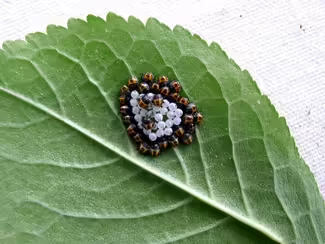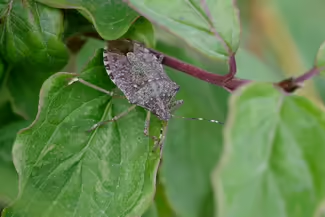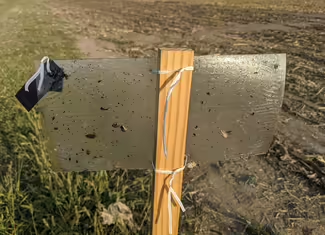Another home invader that we are starting to see more and more of in Illinois is the brown marmorated stink bug (Halyomorpha halys, Stål). This invasive pest is known to feed on over 300 plants and is a threat to vegetables, fruit, and field crops. It is native to Asia and was first reported in the United States in 1998 in Allentown, Pennsylvania.
Since its introduction, it has spread to more than 40 other states. Unlike boxelder bugs and multicolored Asian lady beetle, these insects are more than a nuisance. They will feed on a wide variety of tree fruits, vegetables, crops, and ornamentals and can cause a significant amount of damage. In addition to being an agricultural pest, this stink bug is a nuisance pest with a habit of invading homes in winter in search of overwintering sites.
Download a Brown marmorated stink bug Infosheet
How to Identify Brown Marmorated Stink Bug
The adult brown marmorated stink bug is shield-shaped, measures ½ to ¾ inches in length, and, as their name implies, has a mottled brown color. The adult has alternating black and white bands on its antennae and legs and alternating black and white triangular markings on their abdomen.
The eggs are round, white to pale green in color, and are laid in clusters of 20 to 30 on the underside of leaves. Newly hatched nymphs have red eyes and a yellowish abdomen that eventually turns white with reddish markings. The later nymphal stages develop black and white
bands on the legs and antennae. The nymphs lack functional wings but develop visible wing pads in the last two instars, or molt stages.
There are a few characteristics that can be used to differentiate them from our native stink bugs: the antennae have white bands on them, they have smooth ‘shoulders,’ and they have a black and white triangular pattern on their abdomens.
There are several different types of insects that are commonly confused with BMSB. If you are unsure, contact your local Illinois Extension office.
Biology and Life Cycle
This insect has one or two generations per year, depending on the region of occurrence. In most of the Midwest, it has two generations in a year. It has three stages in its lifecycle: egg, nymph, and adult. The adult emerges from the overwintering sites in spring, and females start laying eggs. In roughly four to five days, the egg hatches into the first instar nymph. BMSB goes through five molts, or instars, each lasting a week, before adulthood. Adults start looking for overwintering sites, often homes and buildings, September through October.
Host Plants and Damage
This stink bug has a broad range of cultivated and non-cultivated host plants. Their feeding injures the fruits and seeds of various crops, including apples, peaches, apricots, grapes, tomatoes, eggplant, pepper, soybeans, and corn. On vegetables, the feeding injury leads to deformed structures and unmarketable crops. In beans and okras, the feeding injury results in scarred and faded sunken areas on the pods, while in fleshy fruits like tomatoes and pepper, the injury leads to white spongy structures on green tomatoes and yellowish on ripened fruit. Feeding also causes indirect damage and transmits pathogens, causing fruit rot like brown rot in tomatoes. Feeding on apples and peaches causes a distinct damage known as cat-facing as well as “corky” spots on the fruit (Fig. 6). On field crops like corn, they feed on the kernel through the husk and the nymph feeds on an ear of corn and feed on developing seeds directly through the pod in soybeans. Both cases lead to substantial yield loss.
How to Manage Brown Marmorated Stink Bugs
The ground deployed black pyramid trap baited with brown marmorated stink bug pheromone lure and methyl decatrienoate is effective in capturing and monitoring both adults and nymphs throughout the season in the orchard. See the detailed protocol for setting up the trap in the article Monitoring for the Brown Marmorated Sting Bug using pheromonebaited traps.
A simpler alternative for monitoring can be a clear sticky trap, which is also cost-effective to growers and is outlined in the Fruit Growers
News article, Simpler trap for monitoring brown marmorated stink bugs eyed. Recommendations for insecticide control vary by host crop and can be found in the Fruit Pest Management Guide or the Midwest Vegetable Production Guide.
Read more from Ken Johnson on the Good Growing blog: Fall House Guests
Authors: Karuna Kafle and Kacie J. Athey.


